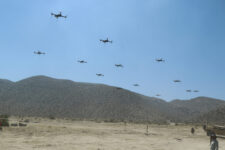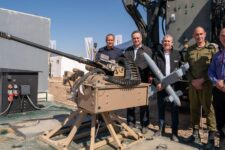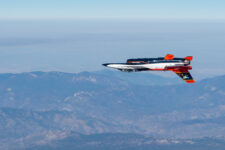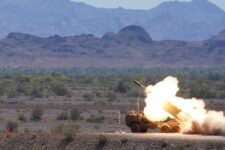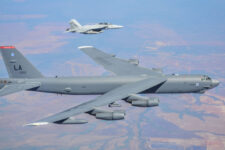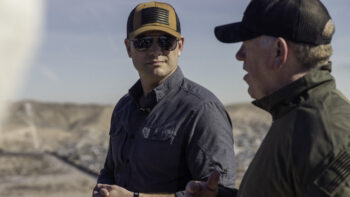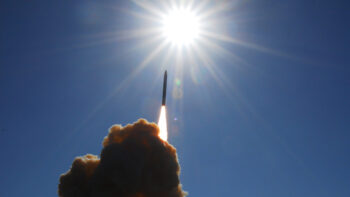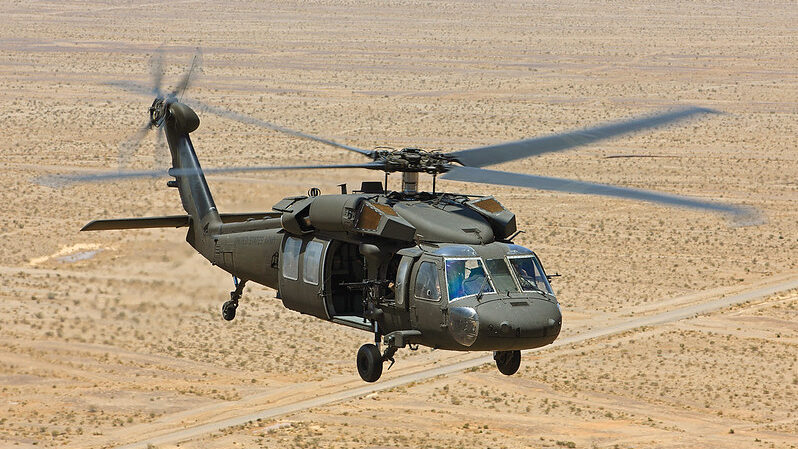
A UH-60M Black Hawk utility helicopter in flight. (Lockheed Martin)
AAAA 2023 — Supply chain issues with the Improved Turbine Engine Program (ITEP) for the Army’s next-gen recon helicopter have trickled down, and the is service now anticipating a two-year delay integrating the new engine into UH-60 Black Hawk helicopters, and later AH-64 Apaches, as well, according to a two-star general charged with aviation acquisition officials.
For several months, service leaders have warned that General Electric’s supply chain woes have postponed ITEP deliveries of the new T901 engines to its first airframes, the Future Attack Reconnaissance Aircraft prototypes. The service was originally shooting for initial ITEP delivery in 2022 but is now aiming to have those first two FARA engines by the end of this calendar year for first flight sometime in 2024. Now the Army says that delay has resulted in postponing its plans to replace the T700 engines in the aircraft next in line, the Black Hawk and Apache helos.
“Like any new development, there have been challenges,” the Program Executive Officer for Aviation, Maj. Gen. Robert Barrie, told reporters on April 27 at Army Aviation Association of America’s annual summit in Nashville, Tenn. To address those hurdles, after FARA integration, the Army will first focus on integrating ITEP into the Black Hawk and has rebaselined that program to factor in a two-year delay.
“In an effort… to push schedule, we did not have any slack in our schedule and that’s no way to manage developmental programs,” the two-star general said. “So, the [new] schedule…does have adequate margin that will be more appropriate for the program management reserve to help us manage and execute.”
When the service submitted its fiscal 2023 budget request to Capitol Hill last year, it detailed plans to wrap up the “engineering and manufacturing development” phase for Black Hawk ITEP work at the beginning of FY25 and award a low-rate initial production contract. That chain of events has now slipped to the third quarter of FY26, or by almost two years, with a full-rate production decision now tracking for the middle of FY28, according to Barrie and FY24 budget request documents.
Although that new schedule has padding to help the team work through any challenges that may arise between now and then, Barrie cautioned that “undoubtedly… additional risks that manifest” once they begin trying to put the new engines into Black Hawks. But for now, the Army is hoping this plan is sufficient and it can also move out on work integrating ITEP into its Apache fleet in the coming years.
“If you look at the long-term sustainment of the fleet, having three aircraft that have commonality of engine does big things for us…[in the] sustainment world later on when you have fleets existing in the force out there,” said Maj. Gen. Michael McCurry, the commanding general of the Army Aviation Center of Excellence and Fort Novosel, Ala.
That promise of commonality and a reduced sustainment burden has helped keep the engine program afloat through difficult times, including the most recent delay that Doug Bush, the service’s head of acquisition, attributed to “quality control” issues associated with sub-vendor components.
“They’ve had trouble making some new components including some new methods, like 3D printing, to the level of quality required for engines that we can actually put in test aircraft,” he told members of the House Armed Services subcommittee.
A GE spokesperson told Breaking Defense on Monday that it is “laser-focused on execution and working closely with the Army to deliver flight-test engines” for FARA by the end of the calendar year. She noted that all components are on hand for the two T901 FARA flight test engines. The first T901 for FARA is in testing and has achieved over 3,100 shaft horsepower, and early tests indicate that the new engine is performing “in accordance with model predictions,” she said.
Publicly, both the Army and company have said they are confident that ITEP is poised to deliver for FARA this year so that Bell-Textron and Sikorsky can complete work on their respective prototypes and get them up in the air for testing. What happens if the ITEP hits additional delays isn’t clear, but Barrie said that the Army, at least for now, has elected not to integrate a surrogate engine into the FARA prototypes.

